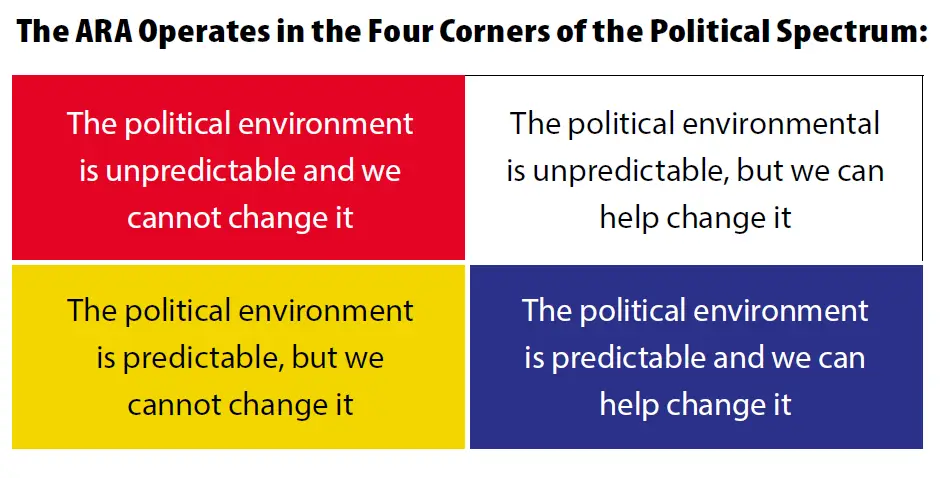by Ken Hendricks, ARA senior industry advisor
Premier John Horgan recently announced his government’s priorities and has issued mandate letters to each ministry. Each letter outlines the government’s strategy for tackling the major political, social, and economic challenges facing us today. Specific to each ministry, the letters outline a mandate to enact policies that support the overall government priorities.
To the passive observer, advocacy can be like watching the grass grow. For the advocate, it can be the process of skillfully navigating a complex labyrinth of unpredictability. It takes both patience and persistence. While government follows an agenda of sorts, its efforts are continually interrupted by political, economic, and social upheaval, not to mention elections, which makes the road to results a long and windy one. Government bureaucracy keeps everything stable and keeps the country on track, but elected officials, coming and going through the democratic process, are constantly moving the goalposts due to shifting priorities. Therefore, it is critical that the ARA’s strategy aligns its advocacy priorities with those of the government, while maintaining a good working relationship within the bureaucracy.
Change in policy can be brought about in a number of ways. Sometimes a change in policy materializes quickly because of a health or public safety crisis, such as what we have witnessed with COVID-19. Other times, change in policy is brought about by large social protests or civil unrest. However, while from an observer’s standpoint, there may appear to be a direct causal link between large gatherings of protesters making a statement on the front lawns of the legislature and changes in policy, any real and lasting change in policy is due to a lot of behind the scenes work and negotiation. It is all the things the observer does not see or hear about that are the real drivers of change.

Before any strategy is implemented, we must consider all four corners of the political spectrum and strategize accordingly. It means prioritizing our resources with what we think we can change and deferring what we cannot, or at least what we can or cannot at any point in time. While we cannot change the outcome, we can work to adapt to it. It also means that the ARA must align its priorities with those of the government. Opportunities present themselves at different times. New opportunities emerge while others are put on hold or are transformed into something new. This has been the strategy over the last several years with the ARA. The NDP took over the reins of power from the Liberals (albeit propped up by the Greens) in 2017. Last year, the NDP were able to assume the full reins of power with a majority government. With the new government came a new way of working with industry and solving problems. The NDP swore in new ministers and the ARA immediately began the work of building new ministerial relations. Of course, we were already known to this government, as it had long been the strategy of the ARA to meet equally with both parties.
What has changed, however, is a fundamental shift in how we view our relationship with government and how they in turn see the ARA. We are witnessing the benefits of this new strategy, which has culminated in a number of our initiatives taking hold. While there are many issues the ARA has positions on, and continues to be actively engaged with, I want to discuss several that are a product of our new strategy and that are being specifically addressed in the government’s new mandate for British Columbia.
Skilled Trades Certification
The issue of skilled trades certification is certainly nothing new and the ARA has a long history of advocating for this initiative on behalf of industry. In the 1990s, the ARA was successful in its efforts for bringing about certified trades designations for automotive technicians. However, in 2001, the liberal government dismantled the system. The ARA continued advocating for a system of skilled trades certification, but other issues arose and it took a back seat to the priorities of the day.
However, the issue resurfaced again in 2013 and emerged as a topic of discussion emanating from the Industry Training Authority’s (ITA) newly formed sector advisory groups (SAGs). The SAGs were put in place to help serve the ITA by providing timely and focused advice to advance and improve the trades training system in B.C. A by-product of these conversations was the recommendation that many of the solutions required by government could be solved through compulsory designation of Red Seal trades. The idea had been met by resistance by the Liberals, but the topic did not go away. Things took a turn when the new NDP government appointed Melanie Mark as minister of advanced education, skills and training.
Melanie Mark adopted a “listen to industry” approach and it was at this pivotal moment that the ARA had shifted its position from “hammering home the idea” that we need skilled trades certification to one of engaging in open dialogue and discussing the nuances and rationale for why we need them and providing evidence to support our position. Moreover, it was here that the whole tone of the discussions within the SAGs had shifted and there was renewed optimism that we could influence a change in policy. There were no guarantees and no promises made, but there were also no heavy-handed demands. Instead, the focus became one of rationale discussion and productive dialogue. This dialogue has produced the desired results and the government’s mandate to the new Minister of Advanced Education, Skills and Training, the Honourable Anne Kang, reads:
“With support from the Ministry of Labour, work with the Industry Training Authority to restore the compulsory trades system to improve safety and give more workers a path to apprenticeship completion.”
Incentives for Used Electric Vehicles
In the letter addressed to the Honourable Bruce Ralston, Minister for Energy, Mines and Low Carbon Innovation, Premier Horgan calls on the minister to “accelerate the adoption of zero-emission vehicles with income-tested rebates and new incentives for purchasing used electric vehicles”. The ARA has been advocating for used electric vehicle incentives for the last few years and presented a case to the Liberals on several occasions without any significant change in policy. However, the opportunity for real change began because of our ability to present the ARA as an association that can be relied upon to work with government toward finding solutions to problems. This strategy has resulted in the government mandate as addressed above.
Incentives for electric vehicles are nothing new, but previous policies have been limited and, the ARA argued, were running counter to growth targets set by the government. The ARA had brought this to the attention of the new government and argued that only by looking at the growth of electric vehicles from a vehicle life cycle perspective will government achieve its targets. This meant increasing the available supply of used electric vehicles to consumers and providing more British Columbians, including industry, with the right incentives. Just as we were met with a new attitude of listening to the concerns of industry when it came to compulsory trade designations, so to were we with this issue.
Again, no promises were made, but the new political environment of open and honest dialogue did allow us to engage in discussions and present the “why” in the form of a proposal to government—not as a demand, but in a manner that demonstrated to government why their current polices were insufficient to meet their targets. In fact, our initial conversation led to our current ZEV (zero-emission vehicle) project, developing an industry training and certification program that will help government meet its targets.
Recognition of Towing and Recovery Operators as Emergency Responders
Last year, regulatory amendments to Part 18 of the WorkSafeBC regulations were presented for public consultation. The ARA responded with a submission. Included within the proposed amendments is a provision that now defines towing and recovery operators as emergency responders when it comes to providing traffic control at an emergency scene. The new section will help provide clarity to the role towing and recovery operators perform while recovering a vehicle on the side of the road or providing roadside assistance to a stranded motorist.
The requirements detailed in Part 18 of the proposed regulatory amendments came about in part of ongoing discussions with industry. The ARA has contributed its part and advocates that operators need to be recognized as roadside emergency responders for the jobs they perform. However, just as with our work in advocating for compulsory trade designations, or providing incentives for used electric vehicles, we have gone far beyond just hammering the point home. Our efforts have been matched by a commitment from industry to work with government and provide solutions on improving the safety standards all workers must meet. We are now embarking on our fifth project with WorkSafeBC to develop an emergency response traffic-control training program for industry that will support the proposed regulations.
In Summary
Our work is by no means finished, and there is still much needed dialogue and work that will occur before policy is enacted. However, our new strategy is serving us well for the challenges that lay ahead and have helped position the ARA as an organization that government will seek out to help find solutions. In fact, we are seeing this happen already as we work toward achieving these goals. And our efforts are not limited to the three issues discussed in this article, but involve all aspects of the organization, its departments, and its divisions. The ARA is maturing as an organization and evolving to meet the demands we face in the twenty-first century.
